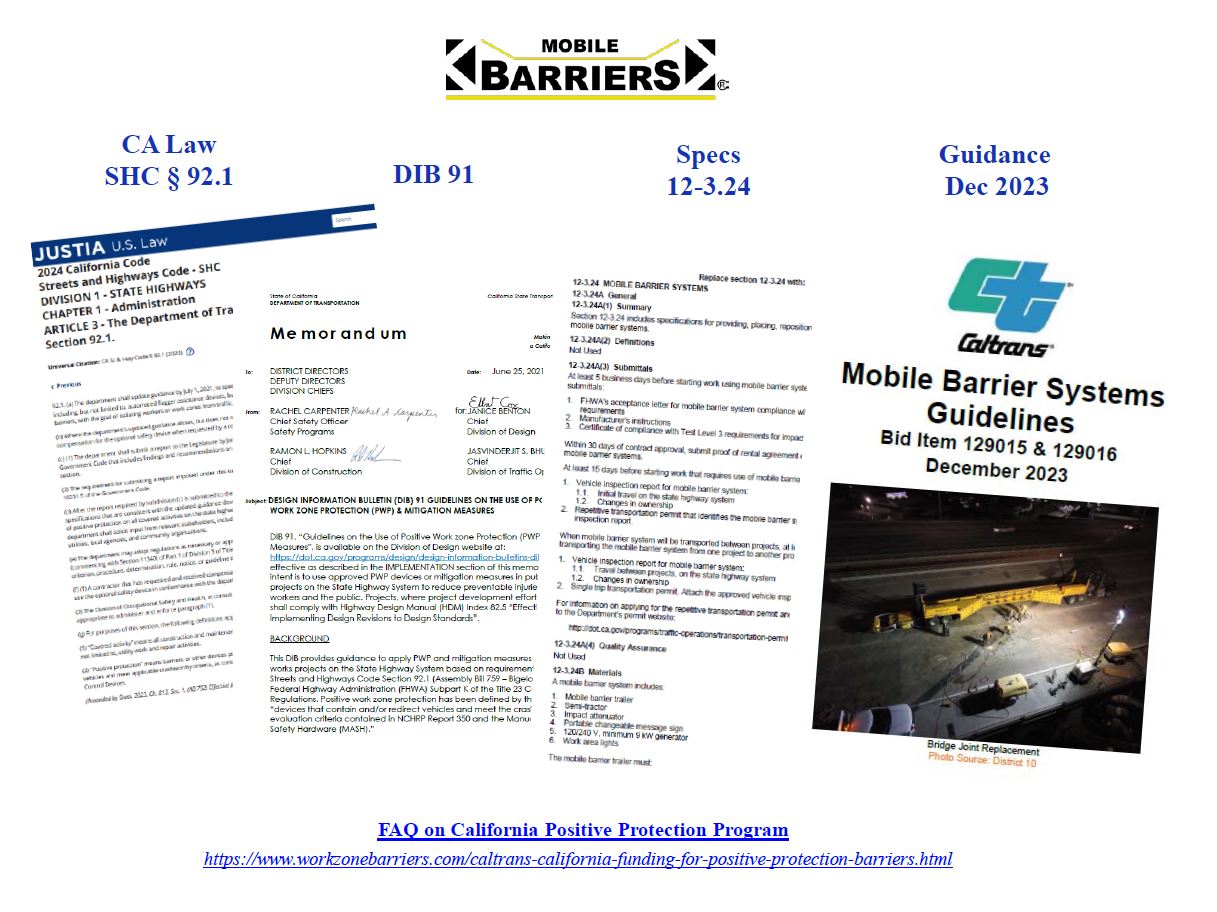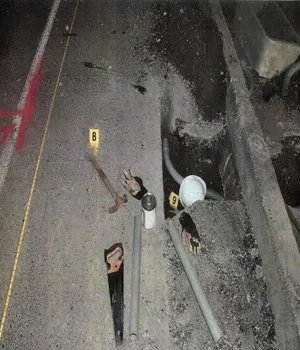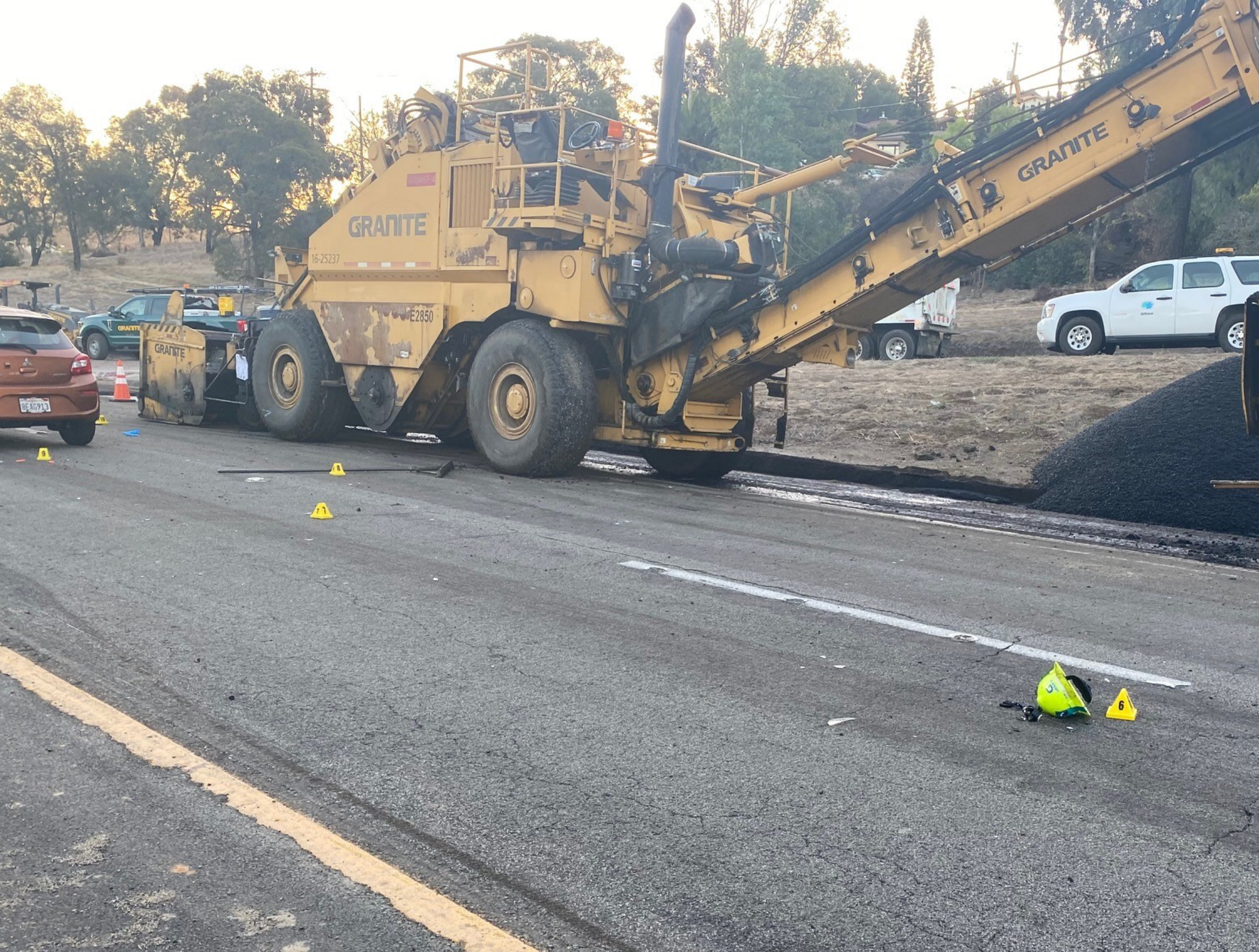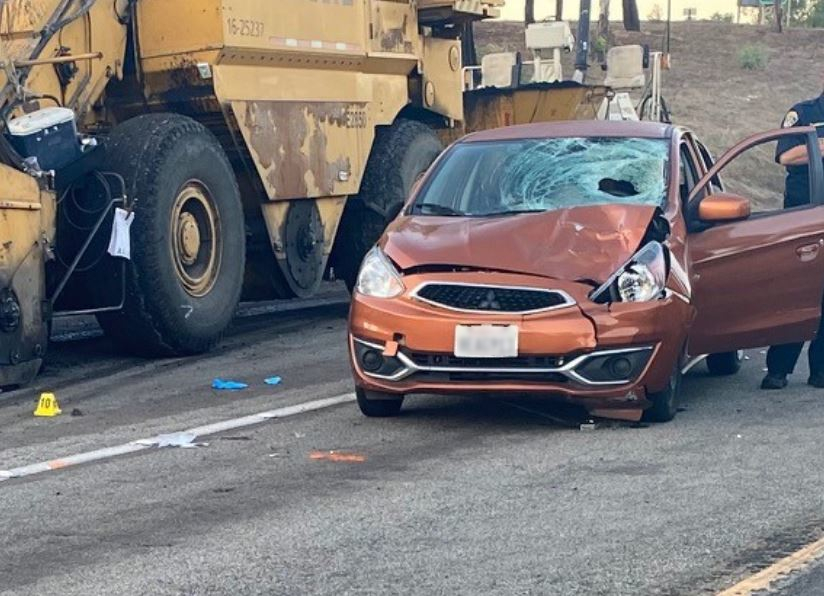Caltrans Positive Protection Program: FAQ for Engineers & Contractors
"...safety, health, and well-being are inherent rights of every worker."
A tragic and preventable 2011 incident led to major safety reforms in 2019 through the enactment of a new law in California. This law, CA SHC § 92.1, directs Caltrans design engineers and Contractors to use Positive Protection to ensure worker safety.
In enacting CA SHC § 92.1, the California State Legislature found and declared in landmark bill AB-759 that:
"People who construct and maintain California's road and transportation infrastructure deserve a safe working environment and to be protected from preventable injury and death".
- What is Caltrans Positive Protection Program?
- What is Positive Protection?
- How to Get Started & Obtain Positive Protection?
- For Design Engineers
- For Contractors
- Example: Documents that help implement MOBILE BARRIER SYSTEMS
- Where Should Positive Protection be Used?
- Why Proactively use Positive Protection?
- Safe System Approach
- Why Death/Serious Injury is Unacceptable
- California Laws Require Positive Protection
1.0 What is Caltrans Positive Protection Program?
In 2021, Caltrans launched a Positive Protection program to ensure worker safety under CA SHC § 92.1. As part of the safety program, Caltrans has developed directives including:
-
📌 Options - Design Information Bulletin (DIB) #91 discusses Positive Protection options:
- Background
- Forms (See section "RESPONSIBILITY" on page 2):
- CEM-1302 for Design/Project Engineers
- CEM-1303 for Resident Engineers
- Options:
- Temporary Concrete Barriers
- Steel Barriers
- Moveable Barrier System
- Mobile Barrier System
- Stationary Impact Attenuator Vehicle
-
╰┈➤ Guidance - Depending on selected option:
-
e.g. "Mobile Barriers System Guidelines, Bid Item 129015 & 129016, December 2023":
- Info
- Examples
- Special Provisions (e.g. 12-3.24)
- Standard Plans (e.g. T24 & T25)
-
e.g. "Mobile Barriers System Guidelines, Bid Item 129015 & 129016, December 2023":
In 2024, Caltrans’ innovative Positive Protection program was publicly praised by the California Transportation Foundation (CTF) and given an award for its groundbreaking work in safety and effectiveness in protecting people at work during short-term stationary operations like guardrail repair, bridge deck maintenance, and lane closures. [1] Positive Protection devices implemented under this program have already been credited with sustaining multiple impacts from errant vehicles. [2]
While accepting the 2024 CTF award, Caltrans senior staff emphasized their commitment to safety, declaring that this Positive Protection program is: "for highway workers, and our own employees, and for city and county employees, and anyone that is out there on the highway system or streets..."
"How do we provide a safer workplace? It’s all about a paradigm shift. It’s not about how much it costs. It’s how we make it safer. By providing the protection to the workers, we’re [effectively] removing the workers from the roadway…and that’s using new technologies.”
2.0 What is Positive Protection?
Positive Protection: "devices that contain and/or redirect vehicles and meet the crashworthiness evaluation criteria contained in National Cooperative Highway Research Program (NCHRP) Report 350 or the Manual for Assessing Safety Hardware (MASH)."
Caltrans Design Information Bulletin (DIB) #91 discusses Positive Protection options:
- Temporary Concrete Barriers,
- Steel Barriers,
- Moveable Barrier System,
- Mobile Barrier System,
- Stationary Impact Attenuator Vehicle.
- Caltrans 12/23/16 MASH Memo sets a timeline for transitioning to MASH.
- Caltrans 12/30/20 MASH Memo sets a sunset date of December 31, 2026 for NCHRP 350 temporary traffic control devices.
-
Caltrans "11/12/19 Memo: MASH Compliance Plan and Policy (PDF)" directs engineers:
"If one or more Caltrans approved MASH compliant safety devices are available for a specific need, Caltrans must use the safety device(s) even if it may require a sole source contract."

3.0 How to Get Started & Obtain Positive Protection?
3.1 For Design Engineers
- 📌 Law: California SHC § 92.1 directs Caltrans design engineers to design in Positive Protection in order to ensure worker safety.
- 📌 Options: Design Information Bulletin (DIB) #91 helps Caltrans design engineers select appropriate Positive Protection options.
- ╰┈➤ Guidance: Caltrans Guidance on options (including Guidance on Mobile Barrier Systems) is also available to assist design engineers.
3.2 For Contractors
- 📌 Law: Contractors can ask for Positive Protection and get a change order under California SHC § 92.1. Speaking up about work zone safety issues could reduce risk & save a life.
- 📌 Options: Contractors can also use Design Information Bulletin (DIB) #91 to help select appropriate Positive Protection.
- ╰┈➤ Guidance: Caltrans Guidance on specific options (including Guidance on Mobile Barrier Systems) is also available to assist contractors.
3.3 Example: Documents that help implement MOBILE BARRIER SYSTEMS
- 📌 Law: CA SHC § 92.1 requires Caltrans to use Positive Protection, as defined, in specified conditions, in order to ensure worker safety (and allows a Contractor to ask for a change order).
- 📌 Options: Caltrans "DESIGN INFORMATION BULLETIN (DIB) 91 GUIDELINES ON THE USE OF POSITIVE WORK ZONE PROTECTION (PWP) & MITIGATION MEASURES"
-
╰┈➤ Guidance: Caltrans document "Mobile Barriers System Guidelines, Bid Item 129015 & 129016, December 2023":
- Caltrans "Standard Special Provision 12-3.24 MOBILE BARRIER SYSTEMS (Dated A04-21-25)"
- Caltrans "Mobile Barrier System Standard Plan T24"
- Caltrans "Mobile Barrier System Standard Plan T25"
- Caltrans "Information Handout [Mobile Barrier System]"
4.0 Where Should Positive Protection be Used?
Caltrans 2021 Design Information Bulletin (DIB) #91, Sections 5.0 - 9.0 provide in-depth discussion and guidance on Positive Protection required usage, typical usage, and engineering analysis.
For example, tunnel, culvert, bridge repair work zones, etc. are known to be especially hazardous with high-speed traffic moving in close proximity to employees, roadside hazards, and/or little or no means for people to escape from errant vehicles and highlight the need for Positive Protection.
High-speeds are especially hazardous.[14][15] A December 2024 IIHS study also found during an impact with a modern taller SUVs and pickup, pedestrians are at extremely high risk. When struck by a median U.S. pickup, a highway worker has an 85% likelihood of severe injury at just 33 mph and an 85% likelihood of dying at just 45 mph. [16]
“As crash speed increases from 15 mph to 35 mph, the risk of a serious injury [for a pedestrian] goes from 9% to 52% when a median-height car is involved. With a median pickup, the risk [of a serious injury for a pedestrian] shoots up from 11% to 91% [as crash speed increases from 15 mph to 35 mph]... The findings point to the need for policymakers and traffic engineers to account for the makeup of the U.S. fleet. A commonly used benchmark for a 'safe' crash speed is one at which the risk of serious injury is 10% or less.”
5.0 Why Proactively use Positive Protection?
5.1 Safe System Approach
- Death/Serious Injury is Unacceptable - "No one should experience either when using the transportation system."
- Safety is Proactive - "Proactively identify and address risks."
- Humans Make Mistakes - "The transportation system can be designed and operated to accommodate human mistakes and injury tolerances and avoid death and serious injuries."
- Humans are Vulnerable - "It is critical to design and operate a transportation system that is human-centric and accommodates human vulnerabilities."
- Responsiblity is Shared - "All stakeholders ... must ensure that crashes don’t lead to fatal or serious injuries."
- Redundancy is Crucial - "If one part fails, the other parts still protect people."
Reflection Question: "Would someone that you deeply care about, such as your own mother, be protected and safe inside this work zone (that you are designing/planning) when a vehicle veers toward it?"
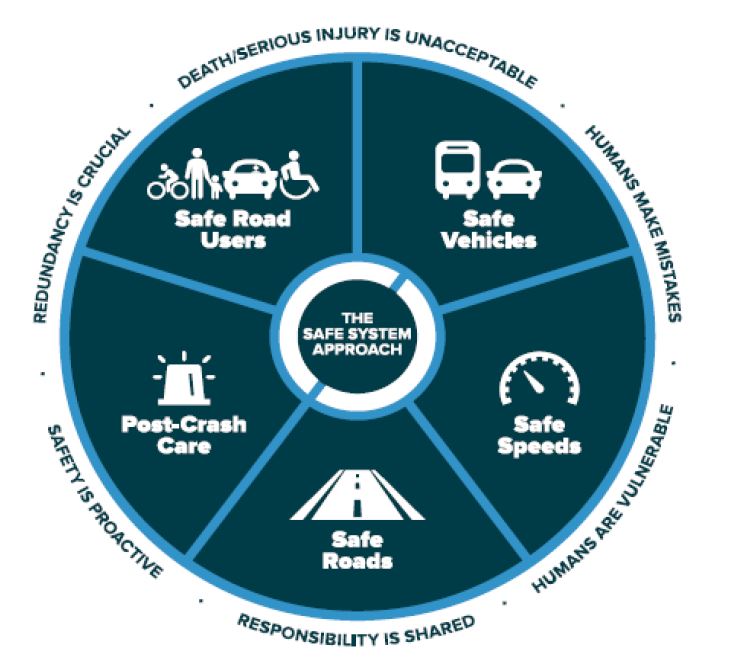
5.2 Why Death/Serious Injury is Unacceptable
"There must be considerable ethical blindness when loss of life is somehow considered an acceptable risk... Ultimately, the deciders, those who are taking the risk of other people's lives in their own hands, have the responsibility of not risking other people's lives. It is as simple as this. There is no such thing as an ethical choice to risk another person’s life...when it is not necessary. If managers do so on account of cost-saving, they are making unethical choices... When we do take steps that minimize risk, we should not consider these steps to be 'managing' risk, but rather as steps that reduce the consequences of risk."
In a 2011 Caltrans incident which resulted in serious injury, a jury essentially found that the engineers' choices took unacceptable risk with other peoples lives (e.g. the choice was made to reject a lane closure, the choice was made to deny the work crew Positive Protection, the choice was made to order the removal of a large vehicle the crew had parked for its own protection, the choice was made to proceed with work in trenches with no means of escape for workers). Those choices resulted in a tragic and preventable incident which left one worker paralyzed for life and unable to speak.
The incident and engineers' choices attracted statewide news coverage, numerous questions, and concern for the safety of people constructing and maintaining California's roads. In July 2019, Caltrans paid a settlement amount of $37.3 million to the injured worker. Three months after the $37.3 million settlement, the California State Legislature initiated major safety reforms in a landmark bill (AB-759) which enacted CA SHC § 92.1 requiring Positive Protection.
"There’s no ‘pretty close’ when it comes to safety on the job. Almost safe means something needs to be corrected immediately before someone gets hurt or killed."
5.2.1 Case-Studies: Preventable Incidents
-
In 2013, retired racing champion Bruce Penhall filed a lawsuit against Caltrans and one of its contractors over son's death.
According to Penhall's lawsuit, an errant vehicle drove over a single cone at the beginning of a lane closure, continued unimpeded for 3,500 feet in the closed lane, and then struck and killed Penhall's 21-year old son. [3] -
In 2017, a jury awarded $56 million to a worker paralyzed in Caltrans incident.
The Sacramento Bee reports that Kyle Anderson, age 20, was working in a trench on a Caltrans wiring project on Highway 101, when a car drifted onto the road shoulder and struck him in the trench. The young man was left paralyzed and unable to speak from injuries he suffered. Caltrans engineers had rejected closing a lane or parking a large vehicle in the shoulder to protect workers. On the morning of the incident, one of the Caltrans workers had Anderson’s crew remove a backhoe it had parked on the road shoulder for protection. After a trial lasting more than two months, a jury assigned “100 percent” of the fault for the incident to Caltrans. The verdict also awards about $2.7 million to another worker from Anderson’s company who was traumatized by the incident. [4] - In a landmark settlement in 2019, Caltrans agreed to pay $37.3 million to paralyzed construction worker, Kyle Anderson, who was severely injured in 2011 in an inadequately protected work zone on Highway 101. [5] [6]
-
In November 2020 in Spring Valley, in a posted 45 MPH work zone, a drowsey driver fell asleep and drifted right into a lane closure at 70 MPH striking multiple cones. The vehicle continued unimpeded for 3 seconds, when it struck 41-year old Emilio Zaragoza (who was a husband, father and son) and threw him more than 50 feet. He died at the scene. "Co-workers and emergency response personnel tried to revive Emilio for over 30 minutes on the side of the road" recounted the California-based contractor.
In an April 2021 CPWR webinar, the contractor reflected on business impacts from the incident: Loss of life, project delayed more than 5 months since the fatality, unexpected immediate business impacts nearing $650k, and "legal costs TBD". [11] In June 2021, the contractor joined in efforts calling on industry and roadway owners "to update state standard specifications to give stronger consideration to the use of barriers between workers and motorists." [12] [13]

Kevin Carnahan, CSP, CHST, regional safety manager at California-based Granite Construction wrote, "We must work collectively and individually to ensure that Emilio, and the thousands like him killed and injured annually in our nation’s work zones, do not die in vain, but instead motivate us to do all that we can to be better." [12]
5.3 California Laws Require Positive Protection
"To protect and safeguard the health, safety, welfare, and property of the public, every person who is licensed by the Board as a professional engineer...shall provide professional services for a project in a manner that is consistent with the laws, codes, ordinances, rules, and regulations applicable to that project."
-
In October 2019, the CA Legislature enacted CA SHC § 92.1 in a landmark bill (AB-759).
[7]
"The Legislature finds and declares both of the following:
- People who construct and maintain California’s roads and transportation infrastructure deserve a safe working environment and to be protected from preventable injury and death. Therefore, protecting construction and maintenance workers is a high priority.
- Requiring the Department of Transportation to specify the appropriate use of positive protection measures, as described in subdivision (a) of Section 92.1 of the Streets and Highways Code, and to provide compensation for optional safety devices when requested by a contractor on a public works project will greatly reduce preventable injuries and deaths to construction and maintenance workers and drivers."
-
In October 2023, the CA Legislature further strengthened work zone safety and CA SHC § 92.1 by requiring Caltrans to use Positive Protection, as defined, in specified conditions, in order to ensure worker safety in another landmark bill (AB-752).
[8]
[9]
California Legislature’s Committee on Transportation found that “According to the Bureau of Labor Statistics, California employs the third highest highway maintenance workforce in the country, at 7,940 jobs… Construction workers engaged in work along roadways and highways face risks not found at traditional jobsites. These are risks inherent to being exposed to vehicular traffic…A physical barrier provides one of the best possible protection solutions for workers exposed to the flow of traffic. [Use of Positive Protection] is a common-sense and cost-effective way for safety reform that will prevent death and injuries of workers on roads and highways.”
Comprehension Check - True or False? "Every day, highway workers put their lives in danger [from errant vehicles] just by going to work..."
False: The statement above is antiquated and no longer true. Today, we have the technology, 'know how', and responsiblity to protect workers from errant vehicles by using Positive Protection.
As the California State Legislature accurately stated in the hearing for AB-752, "A physical barrier provides one of the best possible protection solutions for workers exposed to the flow of traffic. [Use of Positive Protection] is a common-sense and cost-effective way for safety reform that will prevent death and injuries of workers on roads and highways."
|
"Blaming human error alone is convenient, but it places all Americans in greater danger." |
|
"Motorists will inevitably make mistakes. Too often they pay for their mistakes with their lives – or the lives of innocent bystanders.... We have the technology and 'know how' to build our roadway system to anticipate user error. It can be designed, constructed, equipped, and operated to forgive the errant user and protect the innocent victim." |
|
"Engineering has a direct and vital impact on the quality of life for all people. Accordingly, the services provided by engineers require honesty, impartiality, fairness, and equity, and must be dedicated to the protection of the public health, safety, and welfare." |
|
"Safety is a people profession. We want to help workers feel safe, contribute to organizational goals and return home healthy at the end of the workday." |
|
"Do we ever have a right to take decisions that risk other people’s lives? If the message of this chapter is heard, then we do not ever have the right to risk other people’s lives unless we provide full and adequate protection for the consequences of the risk that we are taking with other people’s lives." |
Footnotes
- CPD 23-12 "Postive Work Zone Protection". Available at: https://dot.ca.gov/-/media/dot-media/programs/construction/documents/policies-procedures-publications/cpd/cpd23-12-a11y.pdf
- CPD 21-4 "Work Zone Positive Protection". Available at: https://dot.ca.gov/-/media/dot-media/programs/construction/documents/policies-procedures-publications/cpd/cpd21-4-a11y.pdf

